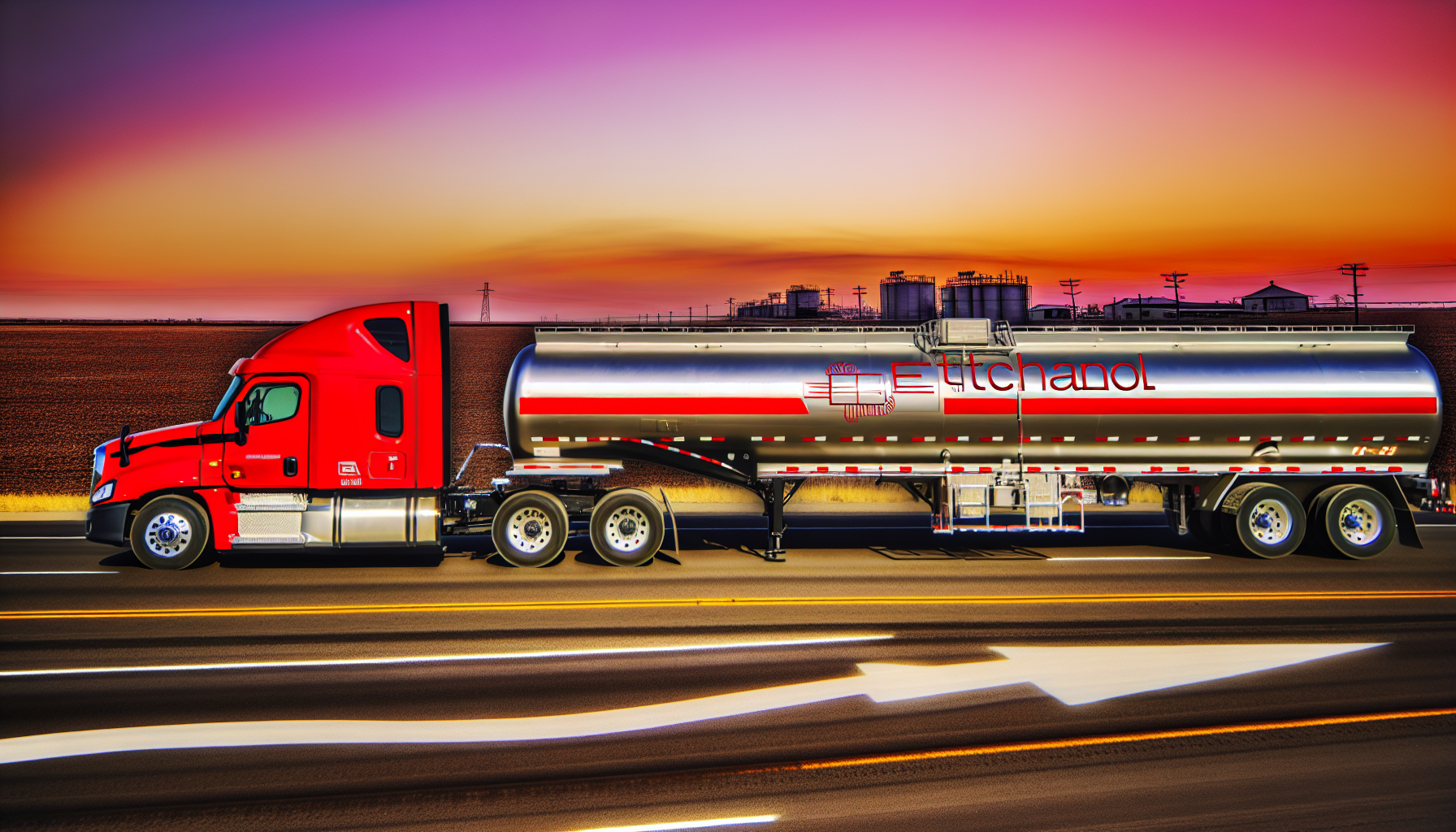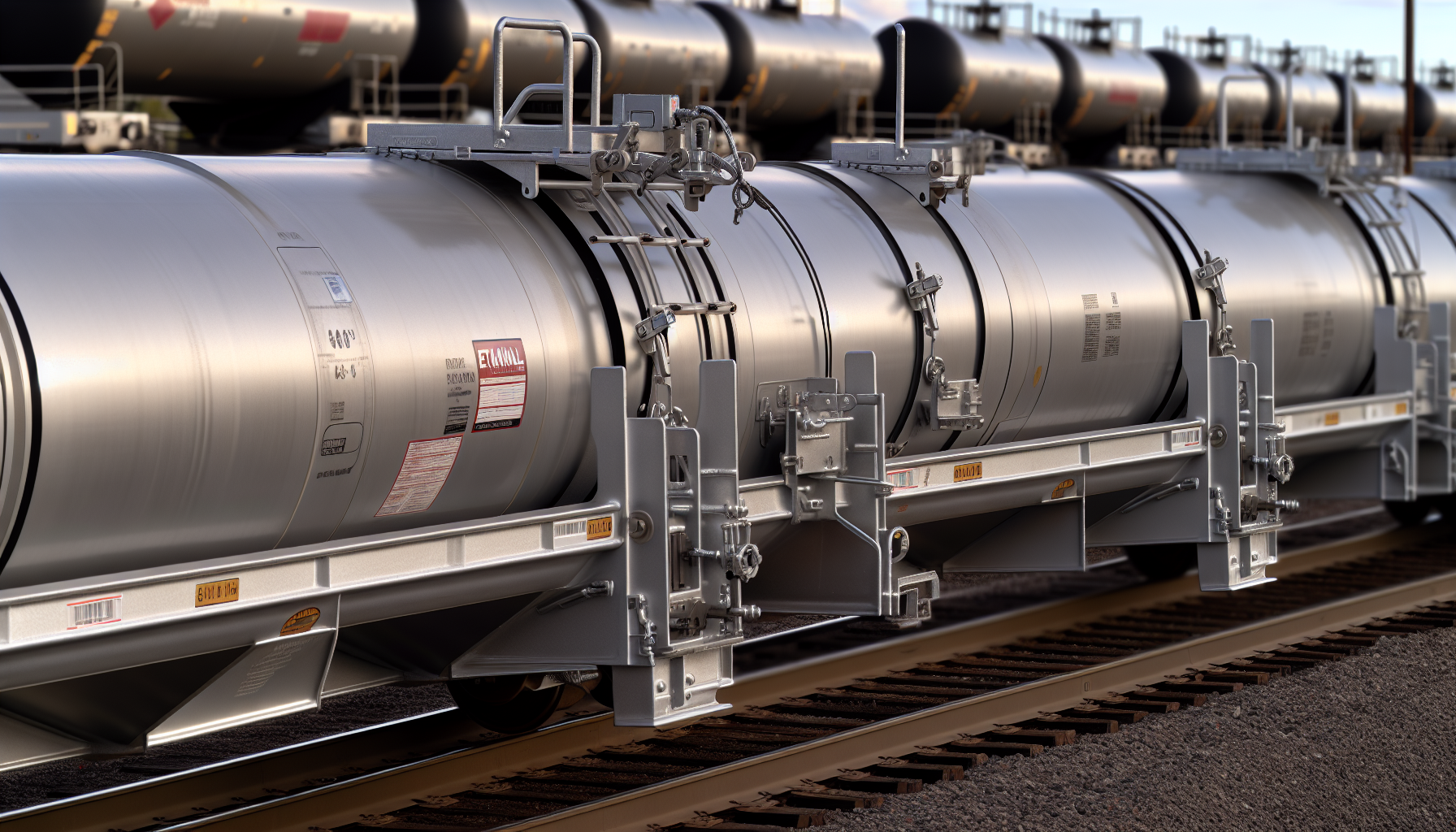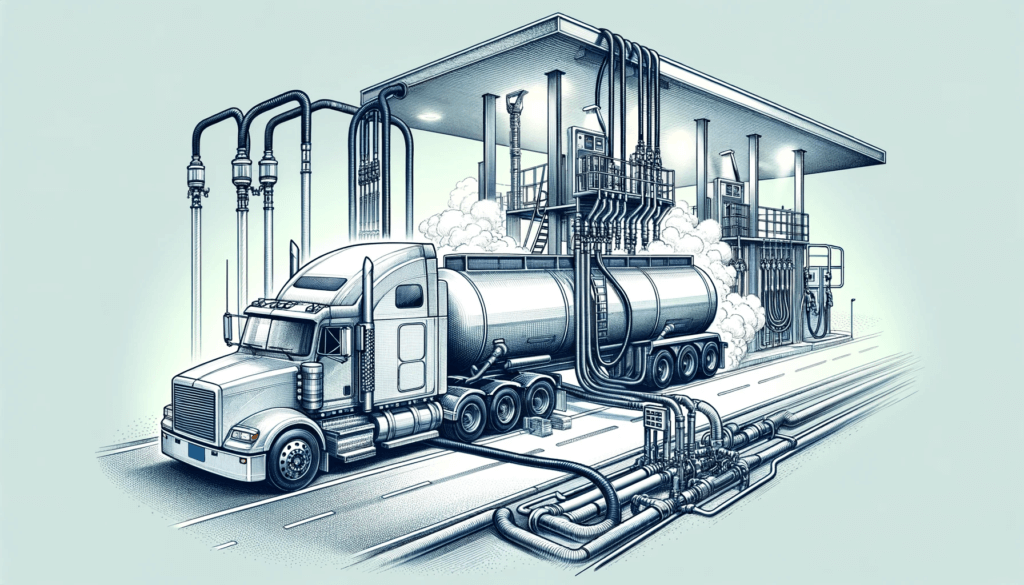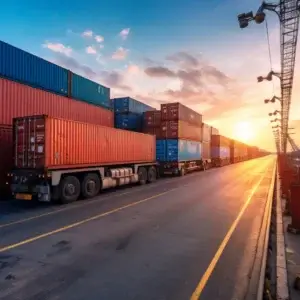In a world increasingly turning towards cleaner, renewable energy sources, ethanol emerges as a robust alternative fuel. However, its volatile nature necessitates careful handling and transportation. Let’s delve into the fascinating world of ethanol and its safe shipping practices, particularly focusing on ethanol tanker shipping.
Key Takeaways
- Ethanol is a widely-applicable alternative fuel produced from various feedstocks.
- Adhering to hazardous material regulations, receiving proper training and following strict loading/unloading routines are essential safety precautions for tanker shipping of ethanol.
- Total Connection provides comprehensive services for ethanol shipping with over 25 years of experience in the field.
Understanding Ethanol: Production, Properties, and Applications

Ethanol, or ethyl alcohol, is a versatile alternative fuel derived from various feedstocks, including some that produce the most ethanol, such as:
- corn
- rice stalks
- sugarcane
- potatoes
- wheat
- sugar beets
The most common production method is dry-mill processing of starch-based crops, although it can also be produced through the fermentation of sugars in grains and utilizing very high gravity (VHG) technology for molasses and other feedstocks.
The diverse range of production methods and feedstocks for ethanol paves the way for its broad application as an alternative fuel in transportation and industrial sectors.
Production Methods and Feedstocks
Within the domain of ethanol production, there are several methods for producing ethanol. These include:
- Using starch-based crops such as corn as feedstock, which is the predominant method in the United States
- Biochemical conversion of cellulosic materials into ethanol, which involves breaking down the cellulose in plant material to release sugars that can be fermented into ethanol
- Thermochemical conversion of cellulosic materials into ethanol, which involves applying heat and chemicals to the feedstock to generate ethanol
These different methods offer flexibility in terms of feedstock availability and sustainability.
Dry-milling, another common method, involves grinding corn into flour and fermenting it to produce ethanol. This method is often favored due to its reduced capital costs.
Ethanol as an Alternative Fuel

As the principal ingredient in alcoholic beverages, ethanol also serves as a cleaner-burning, sustainable alternative to conventional fossil fuels. However, like any other fuel, it comes with its own set of advantages and disadvantages. Despite the lower carbon dioxide emissions produced by ethanol-fueled vehicles, there are challenges such as its lower energy density compared to gasoline, large land requirement for its production, and potential impact on food prices.
Despite the challenges, the significant role of ethanol in our energy landscape continues, with a global production surpassing 28 billion gallons in 2022.
Safety Precautions for Ethanol Tanker Shipping

When handling a potentially hazardous substance like ethanol, maintaining safety is of utmost importance. Here are some key steps to ensure safe transportation of ethanol:
- Adhere to guidelines set by hazardous material regulations, especially when you transport hazardous material like ethanol.
- Receive comprehensive training in the operation of tanker vehicles.
- Follow stringent loading and unloading routines.
By following these steps, you can prevent accidents and ensure the safe transportation of ethanol.
Hazardous Material Classification and Regulations
Classified as a flammable and combustible liquid, ethanol carries the DOT identification number UN 1170 and is designated to the hazard class Class 3 under the Globally Harmonized System of Classification and Labelling of Chemicals (GHS). In the United States, the transportation of this hazardous material is governed by the PHMSA’s Hazardous Materials Regulations, which apply to transportation by:
- rail
- air
- motor carrier
- pipeline
Proper Loading and Unloading Procedures
Safe handling of ethanol tanker shipping is a meticulous process that requires precision and adherence to stringent safety procedures. These include:
- Using Personal Protective Equipment (PPE)
- Verifying that tankers meet prescribed Department of Transportation (DOT) standards
- Following tank truck loading and unloading procedures similar to railcar applications.
Temperature variations also play a significant role, as they can influence the properties of ethanol, necessitating special considerations due to its highly flammable nature and potential for causing eye irritation.
Types of Ethanol Tanker Vehicles and Equipment

The transportation of ethanol involves a range of specialized vehicles and equipment designed to safely carry this volatile substance. From tanker trucks to rail cars and vessels, each mode of transportation has its unique set of specifications and safety features to ensure the safe delivery of ethanol.
Tanker Trucks
Tanker trucks are a common sight on our roads, transporting thousands of gallons of ethanol from production facilities to distribution centers. Made from materials compatible with ethanol, such as stainless steel or aluminum, these trucks incorporate safety features like rollover protection systems, emergency shut-off valves, and vapor recovery systems. They are a flexible and efficient means of transporting ethanol, especially over short to medium distances.
Rail Cars
Rail cars offer a cost-effective solution for long-distance ethanol shipping, while also ensuring safety against potential hazards like carbon monoxide and long term exposure risks. These rail car models adhere to strict DOT-117 safety standards and can be either jacketed or non-jacketed CPC-1232 tank cars.
The older DOT-111 and CPC-1232 models are gradually being replaced by the newer and safer DOT-117 designs, underscoring the industry’s ongoing commitment to safety.
Vessels and Barges
When it comes to large-scale ethanol transportation, especially for international shipments, vessels and barges come into play. These watercraft are designed for bulk liquid cargo and are most effective when train or truck transport is not practical or cost-effective. From freighter ships to dedicated barges, they play a crucial role in the global supply chain of ethanol.
Efficient Ethanol Distribution and Supply Chain Management
The efficient distribution of ethanol is a complex process that requires a well-developed infrastructure and strategic planning. From production sites to distribution centers, each step of the journey is meticulously planned and executed to ensure the safe and timely delivery of ethanol. However, the process is not without its challenges. From infrastructure limitations to environmental concerns and production constraints, the ethanol industry faces a host of issues that require innovative solutions.
Ethanol Transportation Infrastructure
While trucks and trains are the most common means of transporting ethanol, the infrastructure required for ethanol distribution goes beyond these vehicles. It includes pipelines, terminals, and storage facilities, all of which play a crucial role in the efficient and safe transportation of ethanol.
The right infrastructure guarantees reliable and efficient delivery of ethanol to different markets, thus ensuring its availability for use as an alternative fuel.
Challenges and Solutions for Ethanol Distribution
Despite its advantages, the distribution of ethanol comes with its own set of challenges. These include environmental impacts, production limitations, and infrastructure constraints.
Potential solutions include the development of more sustainable production methods, improving distribution efficiency, and exploring alternative fuel sources. In our ongoing pursuit of a more sustainable future, devising strategies to surmount these challenges becomes indispensable.
Different Equipment Needed to Ship Ethanol
The shipping of ethanol involves not just the appropriate vehicles but also the use of specialized equipment. From special valves and connections to vapor recovery systems and pumps, a variety of equipment is necessary to safely and efficiently ship ethanol.
Specialty Valves and Connections Fitted to The Tanker Truck
Specialty valves and connections are essential for the safe and efficient transportation of ethanol. These components, such as API valves and vapor recovery valves, ensure a secure interconnection for the loading and unloading of ethanol and aid in emission control.
Moreover, the safety and efficiency of loading and unloading procedures are ensured by ball valves that regulate the ethanol flow into and out of the tanker compartment.
Vapor Recovery System

A crucial part of the equipment used in ethanol shipping is the vapor recovery system. This system:
- Eliminates vapors that accumulate within sealed hydrocarbon tanks
- Preserves the integrity of the ethanol being transported
- Prevents the emission of harmful pollutants into the environment.
Pump and Aircompressor for Offloading
To ensure efficient and safe unloading of ethanol from tankers, pumps and air compressors play a critical role. These devices, which include Atex Magnetic Drive Pumps, magnetic drive centrifugal pumps, and mechanical seal centrifugal pumps, facilitate the complete emptying of the tanker and transfer of the ethanol through hoses or loading arms.
Emergency Preparedness and Response for Ethanol Shipping Incidents
Despite safety measures and regulations drastically reducing accident risks, emergency preparedness remains a critical aspect. From spill prevention and cleanup to fire safety and extinguishing methods, being ready for potential incidents is a key aspect of ethanol shipping.
Spill Prevention and Cleanup
Spill prevention and cleanup in ethanol shipping incidents are of paramount importance. Here are some crucial steps to take:
- Implement spill control measures at all storage areas
- Use spill socks and absorbents around drains
- Use dikes, dams, or containment systems to keep the ethanol spill away from protected features
By following these steps, you can prevent and effectively manage spills during ethanol shipping incidents.
Fire Safety and Extinguishing Methods
Should a fire erupt during ethanol shipping, familiarity with the correct fire safety measures and extinguishing methods could be life-saving. Using sand or dirt, ABC dry chemical or CO2 fire extinguishers, or Alcohol-Resistant Aqueous Film Forming Foam (AR-AFFF) can effectively extinguish ethanol fires.
Choose Total Connection as Your Ethanol Shipping Partner
Navigating the complexities of ethanol shipping becomes easier with a reliable and experienced partner. Total Connection brings over 25 years of experience in the handling and transportation of hazardous materials, including ethanol. With a comprehensive range of services, from shipment and warehousing to supply chain management, Total Connection can be the reliable partner you need for safe and efficient ethanol shipping.
Summary
In conclusion, the transportation of ethanol, while complex, is an essential aspect of our transition to more sustainable energy sources. Handling this volatile substance requires a comprehensive understanding of its properties, stringent adherence to safety regulations, and the right equipment.
By acknowledging the challenges inherent in the distribution and transportation of ethanol and committing to continuous improvement and innovation, we can ensure the safe, efficient, and sustainable delivery of this crucial alternative fuel.
Frequently Asked Questions
Can ethanol be shipped?
Ethanol can be shipped through domestic mail via air transportation, with special authorization from the director of Product Classification, if all requirements of 343.27 are met.
How do you transport ethanol?
Ethanol is typically delivered to a liquid products terminal, an oil refinery, or directly to a retail fueling station by rail or cargo tank truck transport for short shipping distances.
What is the least expensive way to transport ethanol?
The least expensive way to transport ethanol is by pipeline, as this is the most common way gasoline is shipped. However, there are certain issues preventing this option.
How is ethanol transported in the US?
Ethanol is primarily transported in the US via large tanker trucks and trains. A single truck can carry 8,000-10,000 gallons and a single train car can transport up to 30,000 gallons.
What safety measures need to be considered while transporting ethanol?
Adherence to hazardous material regulations, comprehensive tanker vehicle operation training, and stringent loading/unloading routines are essential for safe ethanol transportation.





